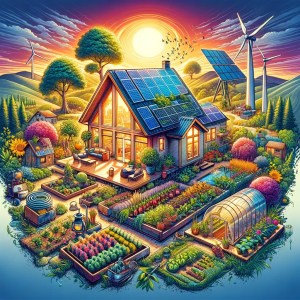- Introduction: Eco-Friendly Home and Garden: Living Sustainably
- II. Embracing Natural Cleaning Solutions
- III. Energy Efficiency at Home: A Path to Sustainability
- IV. Water Conservation: Essential Strategies for Home and Garden
- V. The Art of Sustainable Gardening
- VI. Energy-Efficient Home Improvements and Renovations
- VII. Exploring Water-Smart Landscaping and Gardening Techniques
- VIII. Conclusion: Nurturing a Greener Future Through Sustainable Living
- Join the Simply Sound Society: Your Community for Sustainable Living
Introduction: Eco-Friendly Home and Garden: Living Sustainably

The Significance of Eco-Friendly Living in Homes and Gardens
As we grapple with global environmental challenges, such as climate change and resource depletion, transforming our living spaces into bastions of sustainability becomes imperative. It’s about creating harmonious environments that nourish both nature and our well-being, weaving together practices that conserve resources, reduce waste, and promote ecological balance. The transition to eco-friendly living is a journey of discovery, innovation, and profound respect for the natural world.
Overview of Sustainable Home and Garden Practices
This journey into sustainable living encompasses a wide range of practices, each contributing uniquely to the health of our planet. From the simplicity of natural cleaning solutions to the complexities of energy-efficient systems, every aspect of our domestic life offers opportunities for sustainable choices.
In the pages that follow, we delve deep into the realms of eco-friendly home and garden practices. We’ll explore the benefits and methods of natural cleaning, uncovering ways to maintain our homes without the harsh impact of chemicals. We’ll navigate the path to energy efficiency, harnessing renewable sources like solar power and adopting smart heating solutions to reduce our carbon footprint.
Water conservation, both within our homes and gardens, emerges as a crucial aspect of sustainable living. We’ll discuss impactful water-saving techniques and the art of water-smart landscaping. The enchanting world of sustainable gardening awaits, where principles of organic cultivation, native plant gardening, and natural pest control create thriving ecosystems.
Additionally, we’ll examine the significant role of energy-efficient home improvements and renovations. These include using eco-friendly building materials, upgrading to energy-efficient appliances, and optimizing our homes with effective insulation, windows, and lighting solutions.
As we conclude, we’ll integrate these sustainable practices into a holistic view of daily living. The broader impact of these eco-friendly home and garden choices is immense, contributing not only to our immediate environment but also to the global pursuit of sustainability. This journey is an ongoing process of learning, adapting, and evolving our practices to harmonize with nature’s rhythms.
Join us as we embark on this transformative journey, “Eco-Friendly Home and Garden: Living Sustainably,” where every choice becomes an act of respect and care for our planet.
II. Embracing Natural Cleaning Solutions

The Benefits of Using Natural Cleaning Products
In our pursuit of a cleaner, healthier home, the shift towards natural cleaning solutions is not just a trend, but a vital choice for both environmental and personal well-being. Natural cleaning products offer a plethora of benefits that resonate with the ethos of sustainable living:
DIY Recipes for Eco-Friendly Cleaning Solutions
Embrace the art of creating your own cleaning solutions with these easy, eco-friendly DIY recipes:
Reducing Chemical Exposure in the Home
Mitigating chemical exposure in the home goes beyond just cleaning products. Consider these tips for a healthier living environment:
By embracing natural cleaning solutions and practices, you contribute significantly to a healthier home and a more sustainable world. This journey towards reducing chemical exposure not only enhances the quality of your immediate environment but also aligns with the broader principles of eco-friendly living.
III. Energy Efficiency at Home: A Path to Sustainability

Importance of Energy Conservation in Households
In the fabric of modern living, energy conservation within households plays a pivotal role in the broader narrative of sustainability. This critical endeavor intertwines ecological responsibility with economic prudence, presenting a dual benefit. Here’s why energy conservation is vital:
Harnessing Solar Power for Home Use
Solar power stands at the forefront of renewable energy solutions for homes, offering an eco-friendly alternative to traditional energy sources. Here’s how households can harness this power:
Smart Heating Solutions: Heat Pumps and Energy-Efficient Systems
Modern heating solutions emphasize not just comfort, but also energy efficiency and sustainability. Heat pumps and energy-efficient systems are at the helm of this transformation:
Incorporating these energy-efficient practices and technologies in households paves the way for a more sustainable future. By prioritizing energy conservation, harnessing solar power, and utilizing smart heating solutions, homes can become bastions of environmental stewardship, leading the charge towards a more sustainable and economically sound tomorrow.
IV. Water Conservation: Essential Strategies for Home and Garden
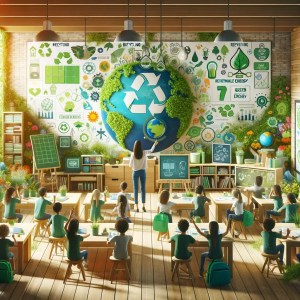
The Impact of Water Usage on the Environment
Water, the elixir of life, is a finite resource that demands careful stewardship. In the context of home and garden use, the way we manage water has profound environmental implications:
Water-Saving Techniques for the Home
In the domestic realm, there are numerous strategies to effectively conserve water:
Eco-Friendly Water Management in Gardening
Sustainable gardening practices can significantly reduce water consumption while maintaining a vibrant garden:
By integrating these water conservation strategies in our homes and gardens, we can significantly lessen our environmental impact. Water conservation is more than a practice; it’s a commitment to preserving our planet’s most vital resource. By adopting these measures, we contribute to a sustainable future, ensuring that this precious resource is available for generations to come.
V. The Art of Sustainable Gardening
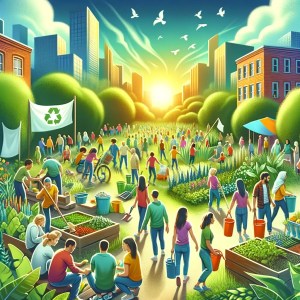
Principles of Sustainable Gardening
Sustainable gardening is an elegant symphony of practices that harmonize with nature. It’s not just about growing plants; it’s about nurturing ecosystems. Here are its key principles:
Benefits of Organic and Native Plant Gardening
Organic and native plant gardening are pillars of sustainable horticulture, offering a cornucopia of benefits:
Composting and Natural Pest Control Methods
Composting and natural pest control are essential tools in the sustainable gardener’s arsenal:
Sustainable gardening is an art that melds aesthetics with ecological responsibility. It’s a testament to our ability to coexist with nature, creating spaces that not only delight the senses but also contribute to the health of our planet. By adhering to these principles and practices, we can cultivate gardens that are not only beautiful and productive but also guardians of our environment.
VI. Energy-Efficient Home Improvements and Renovations
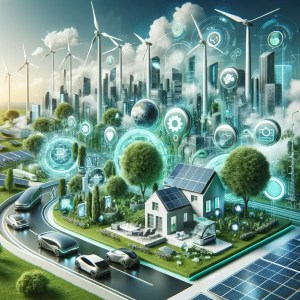
Eco-Friendly Building Materials and Design
In the realm of sustainable living, the materials and design of our homes play a pivotal role. Opting for eco-friendly building materials and designs not only conserves natural resources but also enhances energy efficiency:
Upgrading to Energy-Efficient Appliances
Modern appliances have made leaps in energy efficiency. Upgrading to energy-efficient models can significantly reduce your home’s energy consumption:
Insulation, Windows, and Lighting Solutions
Proper insulation, windows, and lighting are key to an energy-efficient home:
Implementing these energy-efficient home improvements and renovations is a surefire way to reduce your environmental footprint while enhancing the comfort and value of your home. Each step towards energy efficiency not only contributes to a more sustainable future but also results in immediate and long-term savings on energy bills. Embrace these eco-friendly solutions and join the movement towards a more sustainable and energy-efficient world.
VII. Exploring Water-Smart Landscaping and Gardening Techniques
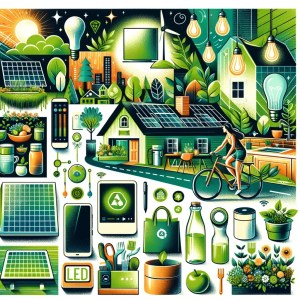
Xeriscaping and Drought-Resistant Plant Selection
Xeriscaping, a landscaping approach designed for water conservation, is pivotal in sustainable gardening. It involves selecting plants that thrive with minimal water, creating landscapes that are both beautiful and environmentally friendly:
Rainwater Harvesting Systems
Implementing rainwater harvesting systems in your garden is an excellent way to use natural resources effectively and reduce dependency on treated water:
Efficient Irrigation and Mulching Methods
Efficient irrigation and mulching are crucial in water-smart gardening, ensuring that plants receive the necessary moisture without wasting water:
By adopting these water-smart landscaping and gardening techniques, you not only conserve precious water resources but also create a more sustainable and resilient garden. These practices not only benefit the environment but can also lead to cost savings and a healthier, more vibrant garden. Embrace these eco-friendly methods and contribute to a more sustainable future, one garden at a time.
VIII. Conclusion: Nurturing a Greener Future Through Sustainable Living

Integrating Sustainable Practices into Daily Living
Adopting sustainable practices in our homes and gardens is not just a series of actions but a profound shift in lifestyle. Integrating these eco-friendly habits into our daily routines transforms our living spaces into examples of environmental stewardship and personal well-being. Small, consistent changes, such as using natural cleaning solutions or optimizing water usage, cumulatively have a significant impact on our environmental footprint. Embracing these practices means contributing to a larger movement of conscious living, where each choice echoes a commitment to preserving our planet for future generations.
The Broader Impact of Eco-Friendly Home and Garden Choices
Our decisions in home and garden management extend beyond personal benefits, influencing broader environmental and societal realms. By choosing eco-friendly materials, conserving resources, and nurturing biodiversity in our gardens, we contribute to the health of our local ecosystems. These choices also ripple outwards, supporting sustainable industries, reducing strain on municipal services, and setting positive examples for our communities. The collective impact of individuals making similar sustainable choices can drive significant environmental change, highlighting the power of individual actions in shaping a sustainable world.
Encouraging Continued Learning and Adaptation in Sustainable Living
The journey towards a more sustainable lifestyle is an evolving process, requiring ongoing learning, flexibility, and adaptation. As we gain new insights and as technologies advance, we must be open to modifying our practices and adopting innovative solutions. Staying informed, sharing knowledge, and learning from others are integral to this journey. We should also encourage and participate in community initiatives, workshops, and forums that foster environmental education and collaborative action.
In this journey, remember that every step, no matter how small, is valuable. Whether you’re starting with a single rain barrel or transforming your entire home into an eco-friendly sanctuary, each action contributes to a larger narrative of sustainability. Let’s continue to explore, implement, and share sustainable practices, nurturing a lifestyle that honors and protects the delicate balance of our natural world. Together, we can ensure that our daily living not only brings joy and health to our lives but also acts as a testament to our dedication to a greener, more sustainable future.
Join the Simply Sound Society: A Forum for Change
Connect with like-minded individuals committed to sustainability in the Simply Sound Society. Share experiences, learn from others, and engage in meaningful discussions about green living. Join us here and be a part of a community that’s shaping a greener, more sustainable world.

Join the Simply Sound Society: Your Community for Sustainable Living
Are you passionate about making a difference in the world through sustainable living? Do you seek a community where ideas, experiences, and insights on eco-friendly practices are shared and celebrated? Look no further — the Simply Sound Society is your destination!
Why Join Simply Sound Society?
- Connect with Like-Minded Individuals: Engage with a community that shares your enthusiasm for environmental stewardship and green living. Here, every member is committed to making a positive impact.
- Exchange Ideas and Learn: Whether you’re a seasoned green warrior or just starting your sustainable journey, there’s always something new to learn. Share your experiences, pick up new tips, and expand your understanding of sustainability.
- Stay Informed and Inspired: Keep up to date with the latest trends, technologies, and practices in sustainable living. Our community brings together diverse perspectives and the latest insights in one dynamic forum.
- Participate in Engaging Discussions: Dive into lively discussions that challenge, inspire, and motivate. From debating the best eco-friendly home practices to brainstorming community initiatives, every conversation is an opportunity to grow and contribute.
- Access Exclusive Content and Resources: Members of the Simply Sound Society get first-hand access to specially curated content, resources, and events. Enhance your knowledge and skills with our exclusive offerings.
- Be Part of a Supportive Network: Embarking on a path to sustainability can be challenging, but you don’t have to do it alone. Our community provides support, encouragement, and a sense of belonging.
How to Join
Becoming a member is easy! Just visit [Simply Sound Society’s webpage] and sign up. Whether you’re looking to make small changes in your daily life or take on larger environmental projects, the Simply Sound Society is here to support and guide you every step of the way.
Make a Difference, Together
In the Simply Sound Society, we believe that collective action is the key to driving meaningful change. Join us today and be part of a movement that is not just about living green, but also about nurturing a sustainable future for all. Your voice, your actions, and your commitment can make a significant difference. Let’s embark on this journey together!









